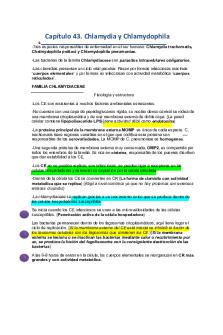Azithromycin Related TO Chlamydia PDF

| Title | Azithromycin Related TO Chlamydia |
|---|---|
| Course | Pharmacological |
| Institution | Chamberlain University |
| Pages | 5 |
| File Size | 75.7 KB |
| File Type | |
| Total Downloads | 95 |
| Total Views | 138 |
Summary
System disorders and med disorder...
Description
Running head: AZITHROMYCIN RELATED TO CHLAMYDIA
Azithromycin Related to Chlamydia Jessica Paczesny Chamberlain College of Nursing NR 293: Pharmacology for Nursing Practice Spring January 2021
1
AZITHROMYCIN RELATED TO CHLAMYDIA
2
Azithromycin Related to Chlamydia Azithromycin is a bacteriostatic macrolide antibiotic that may be used to treat Chlamydia. This antibiotic inhibits protein synthesis of bacteria by binding to the 50S subunit ribosome (Lilley et al., 2020). There are many medications that may treat Chlamydia however, Azithromycin can be the appropriate treatment because it is a bacterial infection. This is a gramnegative bacterium that is transmitted through direct sexual contact and practicing unsafe sex (“STD Information CDC”, 2017). Azithromycin is used to treat specific infection because it can penetrate tissue which will allow the ideal concentrations of the affected tissues. Chlamydia trachomatis requires a host cell to reproduce and this medication particularly fights against bacterial species that may have the tendency to reproduce inside a host cell. Azithromycin is ideal because most other antibiotics only treats infections that exist in the bloodstream or the interstitial spaces (Lilley et al., 2020). Azithromycin has a longer duration of action which will allow the patient to take the drug less often. Once this drug enters the body, it fights targets the Chlamydia trachomatis bacteria and will then bind to the 50S ribosomal subunit, resulting in the ideal medication of choice. By doing so this will inhibit the the growth of the bacteria causing it to eventually die (Lilley et al., 2020). When treating chlamydia, it is important to know the patients past medical history and if they may have an allergic reaction to the drug. Take the medication as prescribed for example: 1g orally in a single dose form. When prescribing a medication, it is important to provide teaching and education to the patient so they can understand and recognize any complications that may arise from taking the medication. Some side effects of this drug include, heart palpitations, chest pain, headaches, dizziness, heartburn, flatulence, anorexia, hearing loss, nausea, and vomiting
AZITHROMYCIN RELATED TO CHLAMYDIA
3
(Vallerand et al., 2019). A urine test or a cotton swab is performed when confirming if the patient may have chlamydia, also it is important to treat the infection as soon as possible with Azithromycin by taking the medication as prescribed and completing taking the required dose even if the patient is feeling better. Completely finishing an antibiotic course is important because it will stop the infection from returning, as well as reduce the risk of the bacteria becoming resistant to the antibiotic (Vallerand et al., 2019).
AZITHROMYCIN RELATED TO CHLAMYDIA
References
Lilley, L. L., Collins, S. R., & Snyder, J. S. (2020). Pharmacology and the nursing process (9th ed.). St. Louis, MO: Elsevier.
Chlamydia - STD information from CDC. (2017, January 04). Retrieved September 03, 2020, from https://www.cdc.gov/std/chlamydia/default.htm
Vallerand, A. H., Sanoski, C. A., & Quiring, C. (2019). Davis's drug guide for nurses (16th ed.). Philadelphia, PA: F. A. Davis Company.
4
AZITHROMYCIN RELATED TO CHLAMYDIA
5...
Similar Free PDFs

coursework related to law
- 17 Pages

mycoplasma ureaplasma chlamydia
- 3 Pages

MCQs related to Article Review
- 3 Pages

Azithromycin Med Sheet
- 2 Pages

Azithromycin - Drug Card
- 3 Pages

Azithromycin ATI - ATI
- 1 Pages

Cap. 43 Chlamydia y Chlamydofila
- 5 Pages
Popular Institutions
- Tinajero National High School - Annex
- Politeknik Caltex Riau
- Yokohama City University
- SGT University
- University of Al-Qadisiyah
- Divine Word College of Vigan
- Techniek College Rotterdam
- Universidade de Santiago
- Universiti Teknologi MARA Cawangan Johor Kampus Pasir Gudang
- Poltekkes Kemenkes Yogyakarta
- Baguio City National High School
- Colegio san marcos
- preparatoria uno
- Centro de Bachillerato Tecnológico Industrial y de Servicios No. 107
- Dalian Maritime University
- Quang Trung Secondary School
- Colegio Tecnológico en Informática
- Corporación Regional de Educación Superior
- Grupo CEDVA
- Dar Al Uloom University
- Centro de Estudios Preuniversitarios de la Universidad Nacional de Ingeniería
- 上智大学
- Aakash International School, Nuna Majara
- San Felipe Neri Catholic School
- Kang Chiao International School - New Taipei City
- Misamis Occidental National High School
- Institución Educativa Escuela Normal Juan Ladrilleros
- Kolehiyo ng Pantukan
- Batanes State College
- Instituto Continental
- Sekolah Menengah Kejuruan Kesehatan Kaltara (Tarakan)
- Colegio de La Inmaculada Concepcion - Cebu








